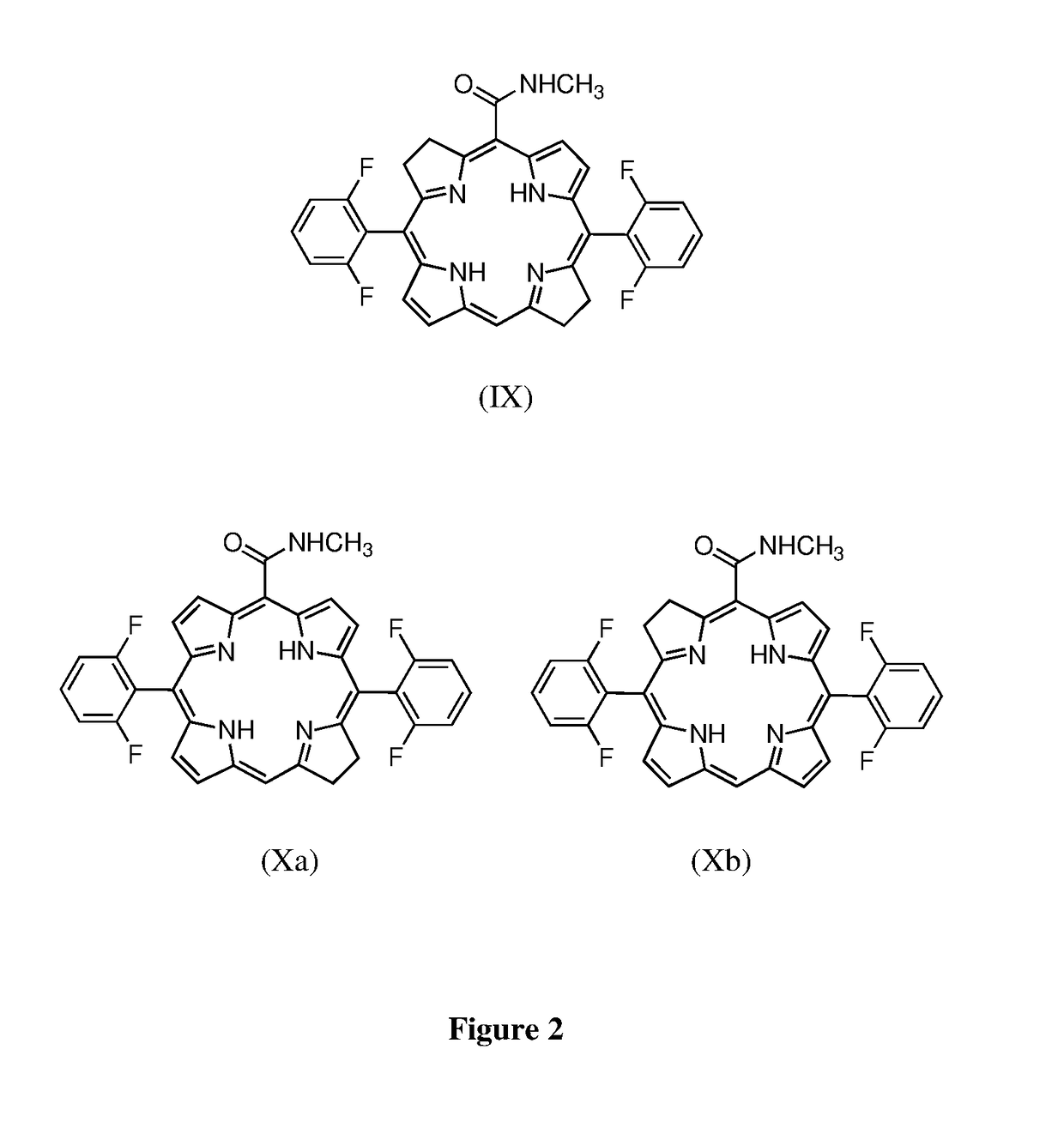Low molecular weight derivatives of carboxamide halogenated porphyrins, namely chlorins and bacteriochlorins, and their applications thereof
a carboxamide halogenated porphyrin, low molecular weight technology, applied in the direction of antibacterial agents, diagnostic recording/measuring, therapy, etc., can solve the problems of incompatibility between large size and large size, and achieve the effect of preventing inactivation and improving dissolution
- Summary
- Abstract
- Description
- Claims
- Application Information
AI Technical Summary
Benefits of technology
Problems solved by technology
Method used
Image
Examples
example 1
for the Preparation of 5-methylcarboxamide-10,20-bis-(2,6-difluorophenyl)chlorin
[0080]The synthesis of 5-methylcarboxamide-10,20-bis-(2,6-difluorophenyl)chlorin was performed by the reaction of p-toluenesulphonyl hydrazide (504±10 mg) with 5-methylcarboxamide-10,20-bis-(2,6-difluorophenyl)porphyrin (VIII) (100±10 mg), potassium carbonate (374±10 mg) and pyridine (15 mL) or alternatively without solvent under inert atmosphere and heating between 100° C. and 150° C., for 2 hours. After cooling to room temperature, DCM (=50 mL) was added and the organic layer washed with hydrochloric acid solution (0.1 M) (3 times) and water (3 times). The organic phase was dried with anhydrous sodium sulfate, filtered and then concentrated. The solid was dissolved in ethyl acetate (20 mL) and a solution of chloranil (0.6 equiv.) in ethyl acetate (5 mL) was added. The final solution was kept under stirring at 45° C. The reaction was stopped when the UV-Vis absorption peak of bacteriochlorin (≈740 nm) h...
example 2
s for the Preparation of 5-methylcarboxamide-10,20-bis-(2,6-difluorophenyl)bacteriochlorin
Solid State Method:
[0087]The synthesis of 5-methylcarboxamide-10,20-bis-(2,6-difluorophenyl)bacteriochlorin (IX) was performed by reaction of p-toluenesulphonyl hydrazide (2.52±0.05 g) with 5-methylcarboxamide-10,20-bis-(2,6-difluorophenyl)porphyrin (0.2±0.05 g), at pressure below 6×10−1 mbar, under heating (140±1° C.) for 60 minutes. After cooling to room temperature the reaction crude was dissolved and purified by chromatography. The 5-methylcarboxamide-10,20-bis-(2,6-difluorophenyl)bacteriochlorin was obtained with 80±5% yield (160±20 mg).
Solvent Method:
[0088]The synthesis of 5-methylcarboxamide-10,20-bis-(2,6-difluorophenyl)bacteriochlorin (IX) was performed by reaction of p-toluenesulphonyl hydrazide (12.5±0.05 g) with 5-methylcarboxamide-10,20-bis(2,6-difluorophenyl)porphyrin (1±0.05 g), potassium carbonate (4.6±0.05 g), 2-methylpyridine (20 mL) and toluene (40 mL) under inert atmosphere ...
example 3
for the Preparation of 5-methylcarboxamide-10,20-bis-(trifluoromethyl)bacteriochlorin
[0094]The synthesis of 5-methylcarboxamide-10,20-bis-(trifluoromethyl)bacteriochlorin (Formula XIV) was performed, using the synthetic and purification conditions of the Solvent Method described in Example 2. The absorption spectrum of XIV in dichloromethane is presented in FIG. 4. The NMR characterization of the isolated product is as follow:
[0095]1H NMR: (400 MHz, CDCl3) δ ppm: −1.00 (s, 1H, NH); −1.07 (s, 1H, NH); 3.30 (d, J=4.7 Hz, 3H, CH3); 4.44-4.48 (m, 2H, β-H); 4.52-4.55 (m, 2H, β-H); 4.61-4.65 (m, 2H, β-H); 8.05 (bs, 1H, —NH); 8.75-8.76 (m, 1H, β-H); 8.84-8.86 (m, 1H, β-H); 8.96 (bs, 2H, β-H+meso-H); 9.03-9.05 (m, 1H, β-H).
Example 4. In Vitro Phototoxicity Towards Propionibacterium Acnes after Light Irradiation
[0096]This example describes the evaluation of in vitro phototoxicity of a carboxamide bacteriochlorin with formula IX after light irradiation, and their potential for PDT applicatio...
PUM
| Property | Measurement | Unit |
|---|---|---|
| optical penetration depths | aaaaa | aaaaa |
| optical penetration depths | aaaaa | aaaaa |
| molecular weights | aaaaa | aaaaa |
Abstract
Description
Claims
Application Information
 Login to View More
Login to View More - R&D
- Intellectual Property
- Life Sciences
- Materials
- Tech Scout
- Unparalleled Data Quality
- Higher Quality Content
- 60% Fewer Hallucinations
Browse by: Latest US Patents, China's latest patents, Technical Efficacy Thesaurus, Application Domain, Technology Topic, Popular Technical Reports.
© 2025 PatSnap. All rights reserved.Legal|Privacy policy|Modern Slavery Act Transparency Statement|Sitemap|About US| Contact US: help@patsnap.com



